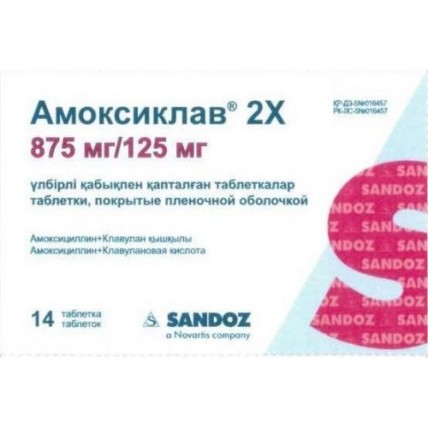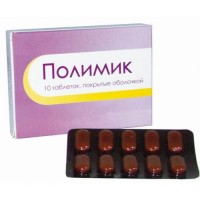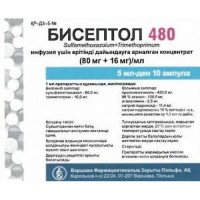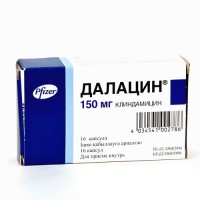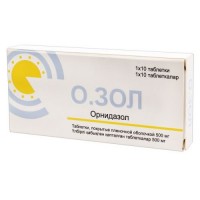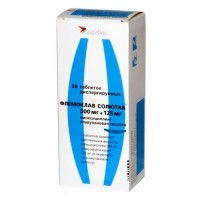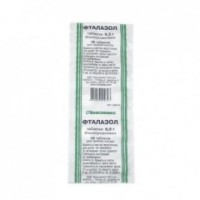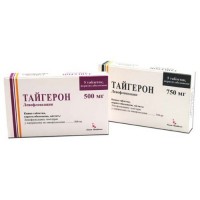Amoxyclav (Amoxycillin / Clavulanic acid) 2X 14s 1000 mg film-coated tablets
- $45.10
Sku:
54da40d416d4
Brand:
Lek (Slovenia)
The instruction for medical use
of Amoksiklav medicine 2X
the Trade name
of Amoksiklav 2X
the International unlicensed name
Is not present
the Dosage form
of the Tablet, film coated 500 mg / 125 mg, 875 mg / 125 mg
Structure
One tablet, film coated contains
active agents: amoxicillin (in the form of trihydrate amoxicillin) 500 mg and clavulanic acid (in the form of clavulanate potassium) 125 mg (for a dosage of 500 mg / 125 mg) or amoxicillin (in the form of trihydrate amoxicillin) 875 mg and clavulanic acid (in the form of clavulanate potassium) 125 mg (for a dosage 875mg/125 mg).
excipients: silicon dioxide colloidal, krospovidon anhydrous, sodium carboxymethylcellulose, magnesium stearate, cellulose microcrystalline dried up.
structure of a film cover: hydroxypropyl cellulose, ethyl cellulose, polysorbate, triethyl citrate, titan dioxide (E 171), talc.
The description of the Tablet, film coated white or almost white color, an oval form with a biconvex surface (for a dosage of 500 mg / 125 mg).
Tablets, film coated white or almost white color, oblong shape, with a facet, with an engraving 875/125 and risky on one party, and an engraving of AMS - on other party (for a dosage of 875 mg / 125 mg).
Pharmacotherapeutic group
Antibacterial drugs for system use. Beta laktamnye antibacterial drugs – Penicillin. Penicillin in a combination with inhibitors beta laktamaz. Clavulanic acid + amoxicillin.
The ATX J01CR02 code
the Pharmacological
Pharmacokinetics Amoxicillin properties and clavulanic acid, are completely dissolved in aqueous solution at physiological values rn organism environments. Both components are well absorbed after intake. To optimum accept amoxicillin/clavulanic acid in time or at the beginning of meal. After intake the bioavailability of amoxicillin and clavulanic acid is about 70%. Dynamics of concentration of drug in plasma of both components is similar. The maximum serumal concentration are reached 1 hour later after reception.
Concentration of amoxicillin and clavulanic acid in blood serum at reception of a combination of drugs of amoxicillin/clavulanic acid are similar to those which are observed at oral separate administration of an equivalent dose of amoxicillin and clavulanic acid.
About 25% of total amount of clavulanic acid and 18% of amoxicillin contact proteins in blood plasma. Distribution volume at oral administration of drug is about 0.3-0.4 l/kg of amoxicillin and 0.2 l/kg of clavulanic acid.
After intravenous administration, both amoxicillin, and clavulanic acid were found in a gall bladder, cellulose of an abdominal cavity, skin, fat, muscle tissue, synovial and peritoneal liquids, bile and pus. Amoxicillin badly gets into cerebrospinal fluid.
Amoxicillin and clavulanic acid get through a placental barrier. Both components pass also into breast milk.
Amoxicillin is partially removed with urine in the form of inactive penitsilloyny acid in the quantities equivalent to 10-25% of an initial dose. Clavulanic acid is metabolized in an organism and removed with urine and excrements and also in the form of carbon dioxide with expired air.
Average elimination half-life of amoxicillin/clavulanic acid makes about 1 hour, and average general clearance about 25 l/h. About 60 - 70% of amoxicillin and 40 - 65% of clavulanic acid are removed from an organism in an invariable view with urine during the first 6 h after reception of a single dose of tablets of amoxicillin/clavulanic acid. During various researches it was revealed that with urine 50-85% of amoxicillin and 27-60% of clavulanic acid within 24 hours are removed. The greatest number of clavulanic acid is removed within the first 2 hours after use.
Simultaneous use of a probenetsid slows down amoxicillin discharge, but this drug does not influence removal of clavulanic acid through kidneys.
Elimination half-life of amoxicillin is similar at children aged from 3 months up to 2 years, also at children of advanced age and adults. At prescription of medicine to very small children (including the premature newborn) in the first weeks of life, it is not necessary to administer the drug more often than two times a day that is connected with immaturity of a renal way of removal at children. Because elderly patients have renal dysfunction more often, it is necessary to appoint with care the drug Amoxiclav 2X to this group of patients, but if it is necessary, it is necessary to carry out monitoring of renal function.
The general clearance of amoxicillin/clavulanic acid in plasma decreases in direct ratio to decrease in functions of kidneys. Decrease in clearance of amoxicillin is more significant in comparison with clavulanic acid as the bigger amount of amoxicillin is removed through kidneys. Therefore, when prescribing drug, dose adjustment is necessary for patients with a renal failure to prevent excessive accumulation of amoxicillin and to keep the necessary level of clavulanic acid.
When prescribing drug the patients should be careful with a liver failure when choosing a dose and to regularly control function of a liver.
The pharmacodynamics
Amoxicillin is a semi-synthetic antibiotic from group of penicillin (beta laktamny an antibiotic) which inhibits one or more enzymes (which are often mentioned as the proteins connecting penicillin), participating in biosynthesis of a peptidoglikan which is an important structural component of a wall of a bacterial cell. The inhibition of synthesis of a peptidoglikan leads to weakening of a wall of a cell which lysis of a cell and its death usually follows.
Amoxicillin collapses the beta lactamelements developed by resistant bacteria, and, therefore, the range of activity of one amoxicillin does not include the microorganisms producing these enzymes.
Clavulanic acid is the beta lactam which is structurally connected with penicillin. It inhibits some beta lactamelements, thereby preventing an amoxicillin inactivation, and expands its range of activity. Clavulanic acid in itself has no clinically significant antibacterial effect.
Time of exceeding is higher than the minimum overwhelming concentration (T & gt, MPK) it is considered the main determinant of efficiency of amoxicillin.
Two main mechanisms of resistance to amoxicillin and clavulanic acid are:
- an inactivation bacterial beta lactamelements which are not suppressed with clavulanic acid, including classes B, C and D.
- change penicillin of the connecting proteins that reduces affinity of antibacterial agent to the activator target.
The impermeability of bacteria or mechanisms of the effluxny pump (transport systems) can cause or maintain stability of bacteria, especially gram-negative bacteria.
The MPK boundary values for amoxicillin / clavulanic acid are those which are defined by the European Committee on testing of antimicrobial sensitivity (EUCAST).
Strains
Limits of sensitivity (mkg/ml)
Sensitive
Moderately resistant
Resistant
Haemophilus influenzae1
≤ 1
-
& gt, 1
Moraxella catarrhalis1
≤ 1
-
& gt, 1
Staphylococcus aureus2
≤ 2
-
& gt, 2
Koagulazonegativny stafilokokki2
≤ 0.25
& gt, 0.25
Enterococcus1
≤ 4
8
& gt, 8
Streptococcus A, B, C, G5
≤ 0.25
-
& gt, 0.25
Streptococcus pneumoniae3
≤
0.5 1-2
& gt, 2
Enterobacteriaceae5
-
-
& gt, 8
Gram-negative anaeroby1
≤ 4
8
& gt, 8
Gram-positive anaeroby1
≤ 4
8
& gt, 8
Boundary value without specific svyazi1
≤
2 4-8
& gt, 8
1 the Published values – for concentration of amoxicillin. For determination
of sensitivity, concentration of clavulanic acid is fixed on 2 mg/l.
2 the Published values – concentration of Oxacillinum.
3 Values of control points in the table are based on control points
of ampicillin.
4 Control point of resistance R & gt, 8 mg/l provide that all strains with
mechanisms of resistance are reported as resistant.
5 Values of control points in the table are based on control points
of benzylpenicillin.
The prevalence of resistance can geographically vary also on time for the chosen types, and local information on resistance is desirable, especially at treatment of heavy infections.
Sensitive strains
Aerobic gram-positive microorganisms: Enterococcus faecalis, Gardnerella vaginalis, Staphylococcus aureus (sensitive to Methicillinum), Streptococcus agalacticae, Streptococcus pneumoniae, Streptococcus pyogenes and other beta and hemolytic streptococci, Streptococcus viridans group
Aerobic gram-negative microorganisms: Capnocyptophaga spp., Eikenella corrodens, Haemophilus influenzae, Moraxella catarrhalis, Pasteurella multocida
Anaerobic microorganisms: Bacteroides fragilis, Fusobacterium nucleatum, Prevotella spp.
Strains which acquired resistance, can cause difficulties
Aerobic gram-positive microorganisms: Enterococcus faecium
Aerobic gram-negative microorganisms: Escherichia coli, Klebsiella oxytoca, Klebsiella pneumoniae, Proteus mirabilis, Proteus vulgaris
Resistant strains
Aerobic gram-negative microorganisms: Acinetobacter sp., Citrobacter freundii, Enterobacter sp., Legionella pneumophila, Morganella morganii, Providencia spp., Pseudomonas sp., Serratia sp., Stenotrophomonas maltophilia
Other strains
of Chlamydophila pneumoniae, Chlamydophila psitacci, Coxiella burnetti, Mycoplasma pneumoniae
Indications
- acute bacterial sinusitis
- acute otitis of a middle ear
- exacerbation of chronic bronchitis
- community-acquired pneumonia
- cystitis
- pyelonephritis
- infections of skin and soft tissues (including phlegmon, stings of animals, parodontalny abscess of a severe form, phlegmon of maxillofacial area)
- infections of bones and joints (in particular osteomyelitis)
the Route of administration and doses
of the Dose are calculated taking into account the content of amoxicillin/clavulanic acid. When choosing a dose of the drug Amoxiclav 2X for treatment of separate infections it is necessary to consider:
- sensitivity of the activator to an antibiotic
- severity and localization of an infection
- age, weight and function of kidneys of the patient, as shown below.
It is also necessary to consider other routes of administration of the drug Amoxiclav 2X, for example, to use higher doses of amoxicillin and/or to appoint amoxicillin and clavulanic acid in various ratios.
A pill should be taken orally before meal to reduce possible gastrointestinal disturbances and to increase absorption of amoxicillin / clavulanic acid.
Adults and children are more senior than 12 years or with body weight more than 40 kg
Appoint on 1 tablet 500 mg / 125 mg 3 times a day or 1 tablet of 875 mg / 125 mg two times a day.
In hard cases in a lower respiratory tract infection, urinary tract, otitis of a middle ear and sinusitis appoint on 1 tablet 875 mg / 125 mg 2 times a day.
Duration of treatment depends on reaction of the patient. Some infections (for example, osteomyelitis) demand longer period of treatment. The maximum time of therapy should not exceed 14 days.
The maximum daily dose for a dosage of 500 mg / 125 mg makes 1500 mg of amoxicillin / 375 clavulanic acid mg, for a dosage of 875 mg / 125 the mg makes 1750 mg of amoxicillin / 250 clavulanic acid mg.
Children are younger than 12 years or with body weight less than 40 kg
This dosage form is not intended for children 12 years or children with body weight less than 40 kg are younger. To such children appoint the drug Amoxiclav 2X in the form of suspension for intake.
Correction of a dose is not required to patients of advanced age.
In a renal failure the correction of a dose is carried out taking into account most recommended amoxicillin level. Dose adjustment is not required when prescribing drug to patients with clearance of creatinine (CrCl) more than 30 ml/min.
At patients who have a creatinine level indicator less 30ml/mines the use of amoxicillin and clavulanic acid in a dose of 875125 mg is not recommended as there are no recommendations about dosing correction.
Adults and children weighing more than 40 kg
Clearance of creatinine: 10-30
ml/min. 500 mg / 125 mg two times a day
Clearance of creatinine:
& lt, 10
ml/min. 500 mg / 125 mg once a day
the Hemodialysis
of 500 mg / 125 mg each 24 hours and in addition 500 mg / 125
to apply mg at the end of dialysis (as concentration of amoxicillin and clavulanic acid in serum decreases) In a liver failure with care. It is necessary
to check functions of a liver regularly.
Side effects
Classification of side effects by emergence frequency:
'it is very frequent' – ³ 1/10, is 'frequent' – from ³ 1/100 to & lt, 1/10, 'infrequently' – from ³ 1/1000 to & lt, 1/100, is 'rare' – from ³ 1/10000 to & lt, 1/1000, 'it is very rare' – & lt, 1/10000, frequency is unknown (the available data are not enough for performance of assessment).
Very often:
- diarrhea
Often:
- candidiasis (skin and mucous membranes)
- toshnota3
- vomiting
Infrequently:
- dizziness, a headache
- a digestive disturbance
- increase in level of nuclear heating plant and/or ALT5
- skin syp7, zud7, krapivnitsa7
is rare:
- the passing leukopenia (including a neutropenia), thrombocytopenia
- multiformny eritema7
Frequency is unknown:
- growth of insensitive organisms
- a passing agranulocytosis, hemolytic anemia, increase in a bleeding time and prothrombin vremeni1
- angioneurotic otek10, anafilaksiya10, syvorotochno-like sindrom10, allergic vaskulit10
- passing hyperactivity, sudorogi2
- an antibiotic - the associated kolit4, black fleecy language, coloring change zubov11
- gepatit6, cholestatic zheltukha6
- Stephens-Johnsona7 syndrome, toxic epidermal nekroliz7, violent exfoliative dermatit7, sharp generalized exanthematous pustulez (AGEP)9
- iterstitsialny nephrite,
kristalluriya8 1 cm undressed Special instructions.
2 cm undressed Special instructions.
3 Nausea are more often at use of higher doses inside. It is possible to reduce
gastrointestinal reactions, accepting amoxicillin / clavulanic acid
at the beginning of meal.
4 Including pseudomembranous colitis and hemorrhagic colitis (see the section Special
instructions).
5 moderate increase in level of nuclear heating plant and/or ALT at the patients
accepting beta laktamnye antibiotics Was noted, but the value of these results is unknown.
6 These complications were noted when using drug in combination with other
penicillin and cephalosporins (see the section Special instructions).
7 At emergence of any skin reaction of hypersensitivity, treatment should
be stopped (see the section Special instructions).
8 cm undressed Special instructions.
9 cm section of the Contraindication.
10 cm undressed Special instructions.
Contraindications
- hypersensitivity to active agent or any auxiliary component of drug
- heavy reaction of hypersensitivity in the anamnesis to other beta
laktamny drugs (for example, to cephalosporins, karbapenema or
monobaktama)
- cholestatic jaundice or other cases of a liver failure in the anamnesis (in connection with use of amoxicillin/clavulanic acid)
- the children's age up to 12 years (with body weight less than 40 kg)
Medicinal interactions
Oral anticoagulants
Oral anticoagulants and antibiotics of penicillinic group is widely used in practice without messages about interaction. However in references the increase in the international normalized relation at the patients accepting atsenokumarol or warfarin together with amoxicillin was noted. If simultaneous use of drugs is necessary, it is necessary to control carefully a prothrombin time or the international normalized relation during the assigning and cancellation of amoxicillin. Moreover, change in a dosage of oral anticoagulants can be required.
Methotrexate
Drugs of penicillinic group can reduce removal of a methotrexate that causes potential increase in toxicity.
Probienieqid
Nie is recommended simultaneous use of a probenetsid. Probienieqid reduces renal canalicular secretion of amoxicillin. Sharing with the drug Amoxiclav 2X can lead to increase in levels of amoxicillin in blood, but not clavulanic acid.
Simultaneous use of Allopyrinolum and drug Amoxiclav 2X can increase risk of emergence of allergic reactions. Data on simultaneous use of Allopyrinolum and the drug Amoxiclav 2X are absent now.
At the patients accepting mikofenolat mofetit, at combined use with the drug Amoxiclav 2X the concentration of an active metabolite of mikofenolovy acid when assigning an initial dose decreases approximately by 50%. Change of level of concentration of an initial dose can not correspond to change of total concentration of mikofenolovy acid.
Special instructions
before therapy by amoxicillin/clavulanic acid, it is necessary to study carefully existence at the patient of reactions of hypersensitivity to penicillin, cephalosporins or others beta laktamnye substances.
Serious and sometimes deadly (anaphylactic) reactions of hypersensitivity were registered at the patients receiving treatment by penicillin. These reactions meet at people with reaction of hypersensitivity to penicillin and an atopy in the anamnesis more often. At development of allergic reaction to amoxicillin/clavulanic acid it is necessary to stop therapy by this drug and to pass to other alternative treatment.
In case the infection was resistant to amoxicillin, it is necessary to consider the possibility of use of amoxicillin/clavulanic acid instead of amoxicillin.
At high risk of resistance of the activator to a beta laktamnym the antibiotics should not use the drug Amoxiclav 2X. Nie is recommended to use drug for treatment resistant to S. pneumoniae penicillin.
At patients with a renal failure and accepting a high dose of drug, spasms can develop.
Nie should appoint amoxicillin/clavulanic acid in an infectious mononucleosis as appearance of korepodobny rash is possible (to amoxicillin).
Simultaneous use of Allopyrinolum during treatment by amoxicillin can increase a likelihood of development of skin allergic reactions. Data on simultaneous use of Allopyrinolum and the drug Amoxiclav 2X are absent now.
Prolonged use of drug can cause the overgrowth of insensitive microorganisms.
Emergence in an initiation of treatment of a generalized erythema with pustulous rashes and fever can be a symptom of development of a sharp generalized exanthematous pustulez. At development of this reaction it is required to stop use of the drug Amoxiclav 2X and not to use amoxicillin in the future any more.
Patients should appoint drug with care with a liver failure.
Cases of appearance of abnormal liver functions were registered generally at men and elderly patients, quite seldom met at children who took the drug during the long span. Signs and symptoms usually develop in time or right after an initiation of treatment, but in certain cases can be shown only in several weeks after the therapy termination. These symptoms are usually reversible. Complications from a liver can be expressed in a severe form and in extremely exceptional cases to proceed from the death. They almost always develop at patients with serious associated diseases or at the patients taking other drugs which influence a liver.
Development an antibiotic - the associated colitis is characteristic of any antibacterial drugs, including amoxicillin, and can vary on degree of manifestation from moderated to zhizneugrozhayushchy. Therefore, it is important to consider this diagnosis when prescribing drug to patients, having diarrhea, in time or after use of any antibiotics. At emergence an antibiotic - the associated colitis, it is necessary to stop use of the drug Amoxiclav 2X immediately. After consultation of the doctor the corresponding therapy has to be appointed. The drugs reducing a vermicular movement are contraindicated in this situation. At long therapy it is regularly recommended to estimate function of systems of bodies, including kidneys, a liver and the haematogenic function. It is necessary correction of a dose of oral anticoagulants for maintenance of desirable level of fibrillation.
At patients with disturbances of functions of kidneys, correction of a dose depending on the degree of manifestation of disturbances is required.
At patients with a reduced diuresis, the crystalluria was very seldom noted, mainly during parenteral therapy. During treatment recommend to the patient plentifully drink to avoid possible development of a crystalluria. According to the obtained data amoxicillin accumulates in bladder catheters (mainly at intravenous administration of high doses), in this case it is necessary to control passability of a catheter regularly.
During treatment using amoxicillin it is necessary to use enzymatic methods of glucose oxydas when carrying out analyses on presence of glucose in urine as when using not of enzymatic methods false positive results are possible.
Presence of clavulanic acid in the drug Amoxiclav 2X can lead to nonspecific binding of immunoglobulin G and albumine with membranes of erythrocytes and to false positive results of test of Koombs. Data on positive takes of the analysis of Bio-Rad Laboratories Platelia Aspergillus EIA at the patients accepting amoxicillin/clavulanic acid which were Aspergillus which are not infected with an infection subsequently were obtained, but there are no data on cross-reactions using non-Aspergillus of polysaccharides and polifuranoz. Thus, positive takes of analyses of the patients accepting amoxicillin/clavulanic acid should be interpreted with care and to confirm with other diagnostic methods. Pregnancy
of the Research animals is not indicated direct or indirect harmful effects concerning pregnancy, by development of an embryo / fruit, childbirth or post-natal development.
Now there is a limited amount of data on use of the drug Amoxiclav 2X during pregnancy at the person which did not reveal the increased risk of congenital malformations. In clinical trial at women with a premature rupture of a fetal membrane the relationship of cause and effect between preventive treatment using amoxicillin/clavulanic acid and the increased risk of a necrotic coloenteritis at the newborn was registered. It is not recommended to use the drug Amoxiclav 2X during pregnancy, use is possible only in urgent cases on doctor's orders.
A lactation
Both active agents are emitted in breast milk (there are no data on influence of clavulanic acid on breastfeeding). Therefore, when breastfeeding the emergence of such symptoms as a diarrhea and fungal infections of mucous membranes is possible, in these cases it is necessary to stop breastfeeding. The drug Amoxiclav 2X is allowed to be used during feeding by a breast only after advantage/risk assessment by the attending physician.
Features of influence of medicine on ability to run the vehicle or potentially dangerous mechanisms
of Researches on identification of the effects influencing an opportunity to drive the car and the equipment it was not carried out. Nevertheless, the drug Amoxiclav 2X can cause such side effects as allergic reactions, spasms which can affect an opportunity to drive the car and moving mechanisms.
Overdose
Symptoms: gastrointestinal symptoms and disturbances of water and electrolytic balance are possible. The amoxicillin crystalluria in certain cases leads to a renal failure. At patients with renal failures or at the patients accepting high doses of drug spasms are possible.
Treatment: symptomatic treatment taking into account water and electrolytic balance. Amoxicillin/clavulanic acid can be brought out of an organism by means of a hemodialysis.
A form of release and packing
On 7 tablets in blister strip packaging from aluminum foil.
On the 2nd blister strip packagings together with the instruction for medical use in the state and Russian languages place in a pack from cardboard.
To Store storage conditions in the dry place at a temperature not above 25 °C.
To store out of children's reach!
2 years
not to use a period of storage after the expiry date specified on packing.
Prescription status
According to the prescription
the Producer / Packer Lek Pharmasyyutikals of of, Slovenia
of Perzonali 47, SI – 2391 Prevalje, Slovenia
the Owner of the registration certificate
Lek Pharmasyyutikals of of, Slovenia
of Verovskova, 57, 1526 Ljubljana, Slovenia
the Address of the organization accepting in the territory of the Republic of Kazakhstan claims from consumers on quality of products (goods) Representative office of JSC Sandoz Pharmasyyutikals d. d. in Republic of Kazakhstan, Almaty, Luganskogo St. 96, Phone number: +7 727 258 10 48, fax: +7 727 258 10 47 e-mail-mail 800 080 0066 – free number of dialing across Kazakhstan
to Develop
of Amoksiklav medicine 2X
the Trade name
of Amoksiklav 2X
the International unlicensed name
Is not present
the Dosage form
of the Tablet, film coated 500 mg / 125 mg, 875 mg / 125 mg
Structure
One tablet, film coated contains
active agents: amoxicillin (in the form of trihydrate amoxicillin) 500 mg and clavulanic acid (in the form of clavulanate potassium) 125 mg (for a dosage of 500 mg / 125 mg) or amoxicillin (in the form of trihydrate amoxicillin) 875 mg and clavulanic acid (in the form of clavulanate potassium) 125 mg (for a dosage 875mg/125 mg).
excipients: silicon dioxide colloidal, krospovidon anhydrous, sodium carboxymethylcellulose, magnesium stearate, cellulose microcrystalline dried up.
structure of a film cover: hydroxypropyl cellulose, ethyl cellulose, polysorbate, triethyl citrate, titan dioxide (E 171), talc.
The description of the Tablet, film coated white or almost white color, an oval form with a biconvex surface (for a dosage of 500 mg / 125 mg).
Tablets, film coated white or almost white color, oblong shape, with a facet, with an engraving 875/125 and risky on one party, and an engraving of AMS - on other party (for a dosage of 875 mg / 125 mg).
Pharmacotherapeutic group
Antibacterial drugs for system use. Beta laktamnye antibacterial drugs – Penicillin. Penicillin in a combination with inhibitors beta laktamaz. Clavulanic acid + amoxicillin.
The ATX J01CR02 code
the Pharmacological
Pharmacokinetics Amoxicillin properties and clavulanic acid, are completely dissolved in aqueous solution at physiological values rn organism environments. Both components are well absorbed after intake. To optimum accept amoxicillin/clavulanic acid in time or at the beginning of meal. After intake the bioavailability of amoxicillin and clavulanic acid is about 70%. Dynamics of concentration of drug in plasma of both components is similar. The maximum serumal concentration are reached 1 hour later after reception.
Concentration of amoxicillin and clavulanic acid in blood serum at reception of a combination of drugs of amoxicillin/clavulanic acid are similar to those which are observed at oral separate administration of an equivalent dose of amoxicillin and clavulanic acid.
About 25% of total amount of clavulanic acid and 18% of amoxicillin contact proteins in blood plasma. Distribution volume at oral administration of drug is about 0.3-0.4 l/kg of amoxicillin and 0.2 l/kg of clavulanic acid.
After intravenous administration, both amoxicillin, and clavulanic acid were found in a gall bladder, cellulose of an abdominal cavity, skin, fat, muscle tissue, synovial and peritoneal liquids, bile and pus. Amoxicillin badly gets into cerebrospinal fluid.
Amoxicillin and clavulanic acid get through a placental barrier. Both components pass also into breast milk.
Amoxicillin is partially removed with urine in the form of inactive penitsilloyny acid in the quantities equivalent to 10-25% of an initial dose. Clavulanic acid is metabolized in an organism and removed with urine and excrements and also in the form of carbon dioxide with expired air.
Average elimination half-life of amoxicillin/clavulanic acid makes about 1 hour, and average general clearance about 25 l/h. About 60 - 70% of amoxicillin and 40 - 65% of clavulanic acid are removed from an organism in an invariable view with urine during the first 6 h after reception of a single dose of tablets of amoxicillin/clavulanic acid. During various researches it was revealed that with urine 50-85% of amoxicillin and 27-60% of clavulanic acid within 24 hours are removed. The greatest number of clavulanic acid is removed within the first 2 hours after use.
Simultaneous use of a probenetsid slows down amoxicillin discharge, but this drug does not influence removal of clavulanic acid through kidneys.
Elimination half-life of amoxicillin is similar at children aged from 3 months up to 2 years, also at children of advanced age and adults. At prescription of medicine to very small children (including the premature newborn) in the first weeks of life, it is not necessary to administer the drug more often than two times a day that is connected with immaturity of a renal way of removal at children. Because elderly patients have renal dysfunction more often, it is necessary to appoint with care the drug Amoxiclav 2X to this group of patients, but if it is necessary, it is necessary to carry out monitoring of renal function.
The general clearance of amoxicillin/clavulanic acid in plasma decreases in direct ratio to decrease in functions of kidneys. Decrease in clearance of amoxicillin is more significant in comparison with clavulanic acid as the bigger amount of amoxicillin is removed through kidneys. Therefore, when prescribing drug, dose adjustment is necessary for patients with a renal failure to prevent excessive accumulation of amoxicillin and to keep the necessary level of clavulanic acid.
When prescribing drug the patients should be careful with a liver failure when choosing a dose and to regularly control function of a liver.
The pharmacodynamics
Amoxicillin is a semi-synthetic antibiotic from group of penicillin (beta laktamny an antibiotic) which inhibits one or more enzymes (which are often mentioned as the proteins connecting penicillin), participating in biosynthesis of a peptidoglikan which is an important structural component of a wall of a bacterial cell. The inhibition of synthesis of a peptidoglikan leads to weakening of a wall of a cell which lysis of a cell and its death usually follows.
Amoxicillin collapses the beta lactamelements developed by resistant bacteria, and, therefore, the range of activity of one amoxicillin does not include the microorganisms producing these enzymes.
Clavulanic acid is the beta lactam which is structurally connected with penicillin. It inhibits some beta lactamelements, thereby preventing an amoxicillin inactivation, and expands its range of activity. Clavulanic acid in itself has no clinically significant antibacterial effect.
Time of exceeding is higher than the minimum overwhelming concentration (T & gt, MPK) it is considered the main determinant of efficiency of amoxicillin.
Two main mechanisms of resistance to amoxicillin and clavulanic acid are:
- an inactivation bacterial beta lactamelements which are not suppressed with clavulanic acid, including classes B, C and D.
- change penicillin of the connecting proteins that reduces affinity of antibacterial agent to the activator target.
The impermeability of bacteria or mechanisms of the effluxny pump (transport systems) can cause or maintain stability of bacteria, especially gram-negative bacteria.
The MPK boundary values for amoxicillin / clavulanic acid are those which are defined by the European Committee on testing of antimicrobial sensitivity (EUCAST).
Strains
Limits of sensitivity (mkg/ml)
Sensitive
Moderately resistant
Resistant
Haemophilus influenzae1
≤ 1
-
& gt, 1
Moraxella catarrhalis1
≤ 1
-
& gt, 1
Staphylococcus aureus2
≤ 2
-
& gt, 2
Koagulazonegativny stafilokokki2
≤ 0.25
& gt, 0.25
Enterococcus1
≤ 4
8
& gt, 8
Streptococcus A, B, C, G5
≤ 0.25
-
& gt, 0.25
Streptococcus pneumoniae3
≤
0.5 1-2
& gt, 2
Enterobacteriaceae5
-
-
& gt, 8
Gram-negative anaeroby1
≤ 4
8
& gt, 8
Gram-positive anaeroby1
≤ 4
8
& gt, 8
Boundary value without specific svyazi1
≤
2 4-8
& gt, 8
1 the Published values – for concentration of amoxicillin. For determination
of sensitivity, concentration of clavulanic acid is fixed on 2 mg/l.
2 the Published values – concentration of Oxacillinum.
3 Values of control points in the table are based on control points
of ampicillin.
4 Control point of resistance R & gt, 8 mg/l provide that all strains with
mechanisms of resistance are reported as resistant.
5 Values of control points in the table are based on control points
of benzylpenicillin.
The prevalence of resistance can geographically vary also on time for the chosen types, and local information on resistance is desirable, especially at treatment of heavy infections.
Sensitive strains
Aerobic gram-positive microorganisms: Enterococcus faecalis, Gardnerella vaginalis, Staphylococcus aureus (sensitive to Methicillinum), Streptococcus agalacticae, Streptococcus pneumoniae, Streptococcus pyogenes and other beta and hemolytic streptococci, Streptococcus viridans group
Aerobic gram-negative microorganisms: Capnocyptophaga spp., Eikenella corrodens, Haemophilus influenzae, Moraxella catarrhalis, Pasteurella multocida
Anaerobic microorganisms: Bacteroides fragilis, Fusobacterium nucleatum, Prevotella spp.
Strains which acquired resistance, can cause difficulties
Aerobic gram-positive microorganisms: Enterococcus faecium
Aerobic gram-negative microorganisms: Escherichia coli, Klebsiella oxytoca, Klebsiella pneumoniae, Proteus mirabilis, Proteus vulgaris
Resistant strains
Aerobic gram-negative microorganisms: Acinetobacter sp., Citrobacter freundii, Enterobacter sp., Legionella pneumophila, Morganella morganii, Providencia spp., Pseudomonas sp., Serratia sp., Stenotrophomonas maltophilia
Other strains
of Chlamydophila pneumoniae, Chlamydophila psitacci, Coxiella burnetti, Mycoplasma pneumoniae
Indications
- acute bacterial sinusitis
- acute otitis of a middle ear
- exacerbation of chronic bronchitis
- community-acquired pneumonia
- cystitis
- pyelonephritis
- infections of skin and soft tissues (including phlegmon, stings of animals, parodontalny abscess of a severe form, phlegmon of maxillofacial area)
- infections of bones and joints (in particular osteomyelitis)
the Route of administration and doses
of the Dose are calculated taking into account the content of amoxicillin/clavulanic acid. When choosing a dose of the drug Amoxiclav 2X for treatment of separate infections it is necessary to consider:
- sensitivity of the activator to an antibiotic
- severity and localization of an infection
- age, weight and function of kidneys of the patient, as shown below.
It is also necessary to consider other routes of administration of the drug Amoxiclav 2X, for example, to use higher doses of amoxicillin and/or to appoint amoxicillin and clavulanic acid in various ratios.
A pill should be taken orally before meal to reduce possible gastrointestinal disturbances and to increase absorption of amoxicillin / clavulanic acid.
Adults and children are more senior than 12 years or with body weight more than 40 kg
Appoint on 1 tablet 500 mg / 125 mg 3 times a day or 1 tablet of 875 mg / 125 mg two times a day.
In hard cases in a lower respiratory tract infection, urinary tract, otitis of a middle ear and sinusitis appoint on 1 tablet 875 mg / 125 mg 2 times a day.
Duration of treatment depends on reaction of the patient. Some infections (for example, osteomyelitis) demand longer period of treatment. The maximum time of therapy should not exceed 14 days.
The maximum daily dose for a dosage of 500 mg / 125 mg makes 1500 mg of amoxicillin / 375 clavulanic acid mg, for a dosage of 875 mg / 125 the mg makes 1750 mg of amoxicillin / 250 clavulanic acid mg.
Children are younger than 12 years or with body weight less than 40 kg
This dosage form is not intended for children 12 years or children with body weight less than 40 kg are younger. To such children appoint the drug Amoxiclav 2X in the form of suspension for intake.
Correction of a dose is not required to patients of advanced age.
In a renal failure the correction of a dose is carried out taking into account most recommended amoxicillin level. Dose adjustment is not required when prescribing drug to patients with clearance of creatinine (CrCl) more than 30 ml/min.
At patients who have a creatinine level indicator less 30ml/mines the use of amoxicillin and clavulanic acid in a dose of 875125 mg is not recommended as there are no recommendations about dosing correction.
Adults and children weighing more than 40 kg
Clearance of creatinine: 10-30
ml/min. 500 mg / 125 mg two times a day
Clearance of creatinine:
& lt, 10
ml/min. 500 mg / 125 mg once a day
the Hemodialysis
of 500 mg / 125 mg each 24 hours and in addition 500 mg / 125
to apply mg at the end of dialysis (as concentration of amoxicillin and clavulanic acid in serum decreases) In a liver failure with care. It is necessary
to check functions of a liver regularly.
Side effects
Classification of side effects by emergence frequency:
'it is very frequent' – ³ 1/10, is 'frequent' – from ³ 1/100 to & lt, 1/10, 'infrequently' – from ³ 1/1000 to & lt, 1/100, is 'rare' – from ³ 1/10000 to & lt, 1/1000, 'it is very rare' – & lt, 1/10000, frequency is unknown (the available data are not enough for performance of assessment).
Very often:
- diarrhea
Often:
- candidiasis (skin and mucous membranes)
- toshnota3
- vomiting
Infrequently:
- dizziness, a headache
- a digestive disturbance
- increase in level of nuclear heating plant and/or ALT5
- skin syp7, zud7, krapivnitsa7
is rare:
- the passing leukopenia (including a neutropenia), thrombocytopenia
- multiformny eritema7
Frequency is unknown:
- growth of insensitive organisms
- a passing agranulocytosis, hemolytic anemia, increase in a bleeding time and prothrombin vremeni1
- angioneurotic otek10, anafilaksiya10, syvorotochno-like sindrom10, allergic vaskulit10
- passing hyperactivity, sudorogi2
- an antibiotic - the associated kolit4, black fleecy language, coloring change zubov11
- gepatit6, cholestatic zheltukha6
- Stephens-Johnsona7 syndrome, toxic epidermal nekroliz7, violent exfoliative dermatit7, sharp generalized exanthematous pustulez (AGEP)9
- iterstitsialny nephrite,
kristalluriya8 1 cm undressed Special instructions.
2 cm undressed Special instructions.
3 Nausea are more often at use of higher doses inside. It is possible to reduce
gastrointestinal reactions, accepting amoxicillin / clavulanic acid
at the beginning of meal.
4 Including pseudomembranous colitis and hemorrhagic colitis (see the section Special
instructions).
5 moderate increase in level of nuclear heating plant and/or ALT at the patients
accepting beta laktamnye antibiotics Was noted, but the value of these results is unknown.
6 These complications were noted when using drug in combination with other
penicillin and cephalosporins (see the section Special instructions).
7 At emergence of any skin reaction of hypersensitivity, treatment should
be stopped (see the section Special instructions).
8 cm undressed Special instructions.
9 cm section of the Contraindication.
10 cm undressed Special instructions.
Contraindications
- hypersensitivity to active agent or any auxiliary component of drug
- heavy reaction of hypersensitivity in the anamnesis to other beta
laktamny drugs (for example, to cephalosporins, karbapenema or
monobaktama)
- cholestatic jaundice or other cases of a liver failure in the anamnesis (in connection with use of amoxicillin/clavulanic acid)
- the children's age up to 12 years (with body weight less than 40 kg)
Medicinal interactions
Oral anticoagulants
Oral anticoagulants and antibiotics of penicillinic group is widely used in practice without messages about interaction. However in references the increase in the international normalized relation at the patients accepting atsenokumarol or warfarin together with amoxicillin was noted. If simultaneous use of drugs is necessary, it is necessary to control carefully a prothrombin time or the international normalized relation during the assigning and cancellation of amoxicillin. Moreover, change in a dosage of oral anticoagulants can be required.
Methotrexate
Drugs of penicillinic group can reduce removal of a methotrexate that causes potential increase in toxicity.
Probienieqid
Nie is recommended simultaneous use of a probenetsid. Probienieqid reduces renal canalicular secretion of amoxicillin. Sharing with the drug Amoxiclav 2X can lead to increase in levels of amoxicillin in blood, but not clavulanic acid.
Simultaneous use of Allopyrinolum and drug Amoxiclav 2X can increase risk of emergence of allergic reactions. Data on simultaneous use of Allopyrinolum and the drug Amoxiclav 2X are absent now.
At the patients accepting mikofenolat mofetit, at combined use with the drug Amoxiclav 2X the concentration of an active metabolite of mikofenolovy acid when assigning an initial dose decreases approximately by 50%. Change of level of concentration of an initial dose can not correspond to change of total concentration of mikofenolovy acid.
Special instructions
before therapy by amoxicillin/clavulanic acid, it is necessary to study carefully existence at the patient of reactions of hypersensitivity to penicillin, cephalosporins or others beta laktamnye substances.
Serious and sometimes deadly (anaphylactic) reactions of hypersensitivity were registered at the patients receiving treatment by penicillin. These reactions meet at people with reaction of hypersensitivity to penicillin and an atopy in the anamnesis more often. At development of allergic reaction to amoxicillin/clavulanic acid it is necessary to stop therapy by this drug and to pass to other alternative treatment.
In case the infection was resistant to amoxicillin, it is necessary to consider the possibility of use of amoxicillin/clavulanic acid instead of amoxicillin.
At high risk of resistance of the activator to a beta laktamnym the antibiotics should not use the drug Amoxiclav 2X. Nie is recommended to use drug for treatment resistant to S. pneumoniae penicillin.
At patients with a renal failure and accepting a high dose of drug, spasms can develop.
Nie should appoint amoxicillin/clavulanic acid in an infectious mononucleosis as appearance of korepodobny rash is possible (to amoxicillin).
Simultaneous use of Allopyrinolum during treatment by amoxicillin can increase a likelihood of development of skin allergic reactions. Data on simultaneous use of Allopyrinolum and the drug Amoxiclav 2X are absent now.
Prolonged use of drug can cause the overgrowth of insensitive microorganisms.
Emergence in an initiation of treatment of a generalized erythema with pustulous rashes and fever can be a symptom of development of a sharp generalized exanthematous pustulez. At development of this reaction it is required to stop use of the drug Amoxiclav 2X and not to use amoxicillin in the future any more.
Patients should appoint drug with care with a liver failure.
Cases of appearance of abnormal liver functions were registered generally at men and elderly patients, quite seldom met at children who took the drug during the long span. Signs and symptoms usually develop in time or right after an initiation of treatment, but in certain cases can be shown only in several weeks after the therapy termination. These symptoms are usually reversible. Complications from a liver can be expressed in a severe form and in extremely exceptional cases to proceed from the death. They almost always develop at patients with serious associated diseases or at the patients taking other drugs which influence a liver.
Development an antibiotic - the associated colitis is characteristic of any antibacterial drugs, including amoxicillin, and can vary on degree of manifestation from moderated to zhizneugrozhayushchy. Therefore, it is important to consider this diagnosis when prescribing drug to patients, having diarrhea, in time or after use of any antibiotics. At emergence an antibiotic - the associated colitis, it is necessary to stop use of the drug Amoxiclav 2X immediately. After consultation of the doctor the corresponding therapy has to be appointed. The drugs reducing a vermicular movement are contraindicated in this situation. At long therapy it is regularly recommended to estimate function of systems of bodies, including kidneys, a liver and the haematogenic function. It is necessary correction of a dose of oral anticoagulants for maintenance of desirable level of fibrillation.
At patients with disturbances of functions of kidneys, correction of a dose depending on the degree of manifestation of disturbances is required.
At patients with a reduced diuresis, the crystalluria was very seldom noted, mainly during parenteral therapy. During treatment recommend to the patient plentifully drink to avoid possible development of a crystalluria. According to the obtained data amoxicillin accumulates in bladder catheters (mainly at intravenous administration of high doses), in this case it is necessary to control passability of a catheter regularly.
During treatment using amoxicillin it is necessary to use enzymatic methods of glucose oxydas when carrying out analyses on presence of glucose in urine as when using not of enzymatic methods false positive results are possible.
Presence of clavulanic acid in the drug Amoxiclav 2X can lead to nonspecific binding of immunoglobulin G and albumine with membranes of erythrocytes and to false positive results of test of Koombs. Data on positive takes of the analysis of Bio-Rad Laboratories Platelia Aspergillus EIA at the patients accepting amoxicillin/clavulanic acid which were Aspergillus which are not infected with an infection subsequently were obtained, but there are no data on cross-reactions using non-Aspergillus of polysaccharides and polifuranoz. Thus, positive takes of analyses of the patients accepting amoxicillin/clavulanic acid should be interpreted with care and to confirm with other diagnostic methods. Pregnancy
of the Research animals is not indicated direct or indirect harmful effects concerning pregnancy, by development of an embryo / fruit, childbirth or post-natal development.
Now there is a limited amount of data on use of the drug Amoxiclav 2X during pregnancy at the person which did not reveal the increased risk of congenital malformations. In clinical trial at women with a premature rupture of a fetal membrane the relationship of cause and effect between preventive treatment using amoxicillin/clavulanic acid and the increased risk of a necrotic coloenteritis at the newborn was registered. It is not recommended to use the drug Amoxiclav 2X during pregnancy, use is possible only in urgent cases on doctor's orders.
A lactation
Both active agents are emitted in breast milk (there are no data on influence of clavulanic acid on breastfeeding). Therefore, when breastfeeding the emergence of such symptoms as a diarrhea and fungal infections of mucous membranes is possible, in these cases it is necessary to stop breastfeeding. The drug Amoxiclav 2X is allowed to be used during feeding by a breast only after advantage/risk assessment by the attending physician.
Features of influence of medicine on ability to run the vehicle or potentially dangerous mechanisms
of Researches on identification of the effects influencing an opportunity to drive the car and the equipment it was not carried out. Nevertheless, the drug Amoxiclav 2X can cause such side effects as allergic reactions, spasms which can affect an opportunity to drive the car and moving mechanisms.
Overdose
Symptoms: gastrointestinal symptoms and disturbances of water and electrolytic balance are possible. The amoxicillin crystalluria in certain cases leads to a renal failure. At patients with renal failures or at the patients accepting high doses of drug spasms are possible.
Treatment: symptomatic treatment taking into account water and electrolytic balance. Amoxicillin/clavulanic acid can be brought out of an organism by means of a hemodialysis.
A form of release and packing
On 7 tablets in blister strip packaging from aluminum foil.
On the 2nd blister strip packagings together with the instruction for medical use in the state and Russian languages place in a pack from cardboard.
To Store storage conditions in the dry place at a temperature not above 25 °C.
To store out of children's reach!
2 years
not to use a period of storage after the expiry date specified on packing.
Prescription status
According to the prescription
the Producer / Packer Lek Pharmasyyutikals of of, Slovenia
of Perzonali 47, SI – 2391 Prevalje, Slovenia
the Owner of the registration certificate
Lek Pharmasyyutikals of of, Slovenia
of Verovskova, 57, 1526 Ljubljana, Slovenia
the Address of the organization accepting in the territory of the Republic of Kazakhstan claims from consumers on quality of products (goods) Representative office of JSC Sandoz Pharmasyyutikals d. d. in Republic of Kazakhstan, Almaty, Luganskogo St. 96, Phone number: +7 727 258 10 48, fax: +7 727 258 10 47 e-mail-mail 800 080 0066 – free number of dialing across Kazakhstan
to Develop
